Astana isn't actually the last stop on the train from Almaty, but it's where almost everyone gets off. Because there really weren't any decent options available in Astana at the time (though the folks behind the Apple Hostel in Almaty, overwhelmed by the popularity of their hostel, have
opened a branch in Astana), I decided to stay at the Station Hotel, which offered dorm accommodation for 2,500 tenge per night. The ladies working at the hotel were actually pretty friendly, which is always a bit of a surprise at an institutional hotel with Soviet roots.
Although the train station is some distance from the new city and its architectural attractions, it's still pretty convenient since buses run south along the main street to Khan Shatyr pretty frequently, and it's dead easy to get off the train and check in. Unfortunately, because most guests are taking the train, it means you have people checking in and checking out at all hours of the day or night—whenever a train arrives or leaves. And because of this constant churn, the staff changes the linens as soon as someone checks out, which means you will have noise at random times when you're trying to sleep. As with many other Soviet-style hotels, you need to pay extra to get a key to the shower: 3,000 tenge.
I took a quick nap after arriving and walked south towards the new city. Around the station the city is kind of a dreary Russian-looking city: a little bleak, not a lot of trees, large and characterless blocks of buildings (although the ground floors were typically occupied by modern shops and restaurants).
Although it was only mid-September, the change in climate was immediately noticeable, as Astana was much colder and windier than Almaty, and the vegetation nowhere near as lush or varied. In many ways, Astana felt like Calgary: dry, cool, and relatively inhospitable to most trees.
The further south you get, the more modern the buildings look, and when you cross the river and arrive on the left bank you truly arrive in the world of weird architecture in a planned city.
Almaty's building boom started when Astana was named the capital, in 1997. Although Almaty is a gorgeous city and one of the gems of Central Asia, it's also on the southern edge of Kazakhstan, next to Kyrgyzstan and quite close to China. The move to Astana, some 1,200 km closer to Moscow, emphasizes the importance and primacy of Kazakhstan's relationship with Russia, while also creating an indisputable Kazakh presence in the ethnically-Russian north and providing the platform for the creation of a showcase city to announce Kazakhstan's bold ambition and new-found prosperity.
Most of the interesting new buildings are south of the Ishim river, which has been artificially widened as it runs through Astana. This southern area is romantically called the left bank, but it's no Paris. Almost all of the buildings are arranged along an axis known as
Nurzhol Boulevard, which runs from the Khan Shatyr shopping center in the west to the Presidential Palace along the Ishim river in the east, and then continuing along the same axis on the other side of the river with a number of additional monuments. From one end of the other it's about 5 km in length, and long-term plans call for this axis of monuments to be extended considerably.
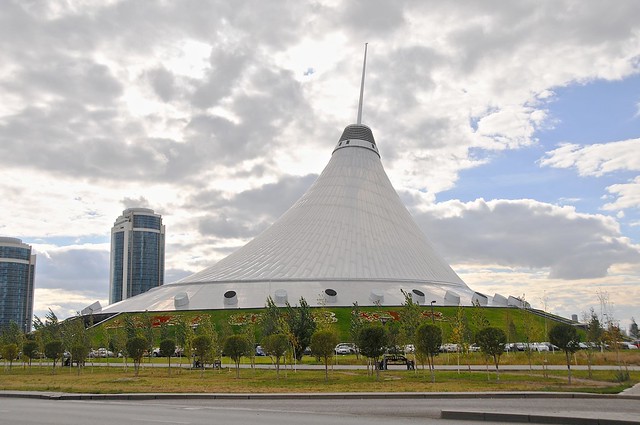 |
| The exterior of Sir Norman Foster's Khan Shatyr shopping center. Security is pretty tight, and you have to go through metal detectors and security scrutiny as you enter. The building apparently cost $400,000,000 to build. |
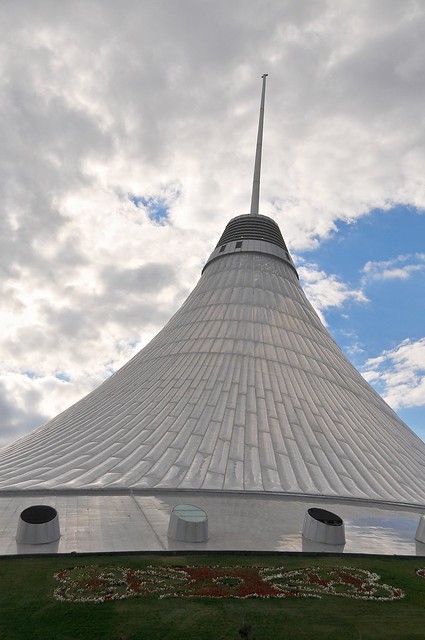 |
| Traditional design in flowers. |
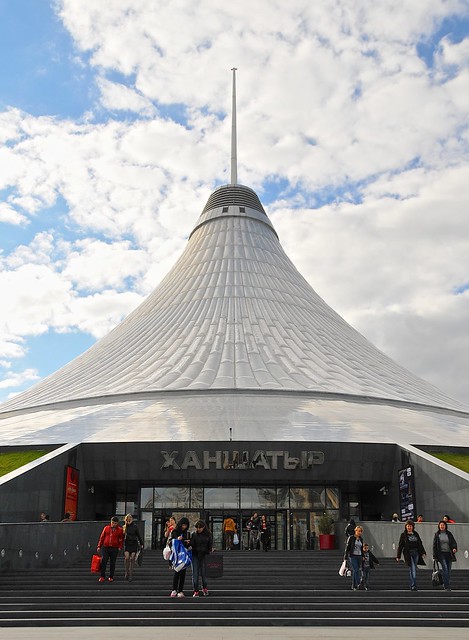 |
| The main entrance. |
 |
| KHAN SHATYR!!!! For someone used to more differentiation between upper and lower case, Cyrillic can look monotonous and shouty. |
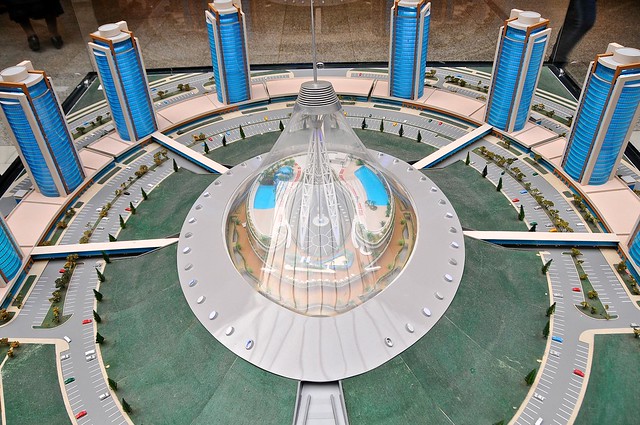 |
| A model of the central building with the networked apartment buildings that will surround it. You can see the pools and beaches on the top floors of the model. |
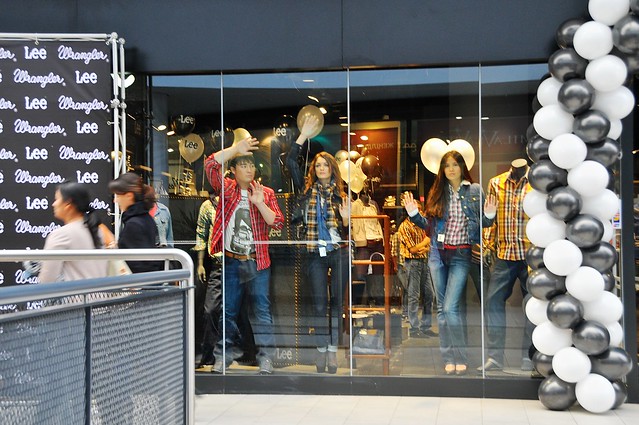 |
| Speaking of models, they had models as live mannequins at this Wrangler store. They would take a pose for 30 seconds or so, then move around and take up new poses. This picture kind of sucks because I tried to take it surreptitiously, since it seemed weird to take pictures of them, even if they were models. |
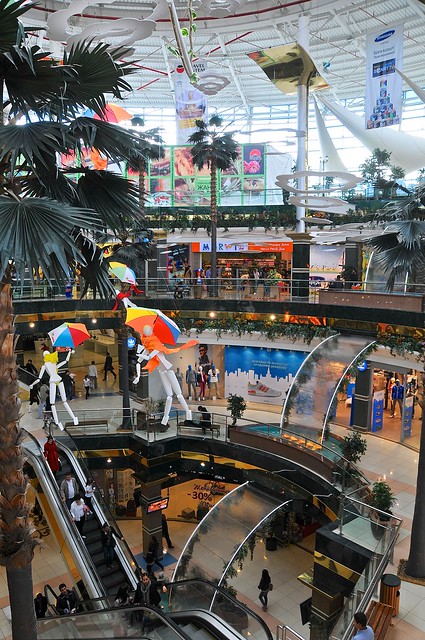 |
| Inside Khan Shatyr. It has about everything you could imagine, including a beach. |
|
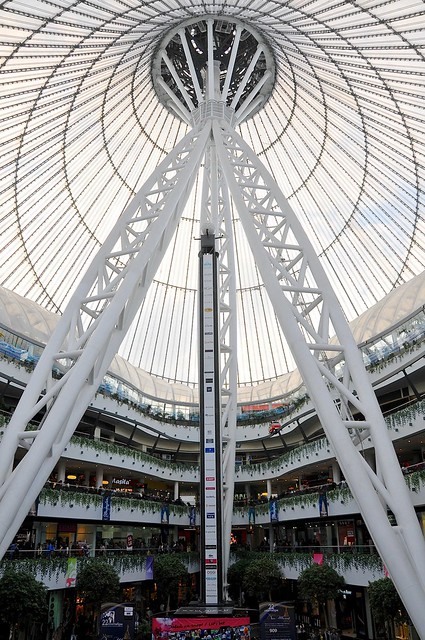 |
| Looking up the atrium from a lower level. That's one of those scary-drop rides in the middle. |
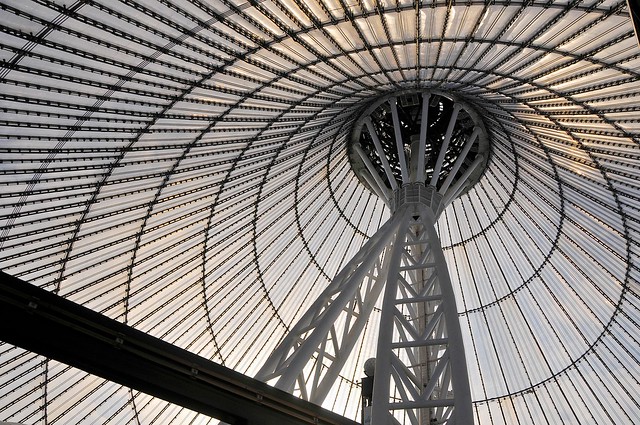 |
| Looking up at the central tent pole. |
 |
| On the upper levels you can get pretty close to the membrane. The Triumph of Astana, modeled on Stalin's Skyscrapers (The Seven Sisters) in Moscow, is visible in the background. |
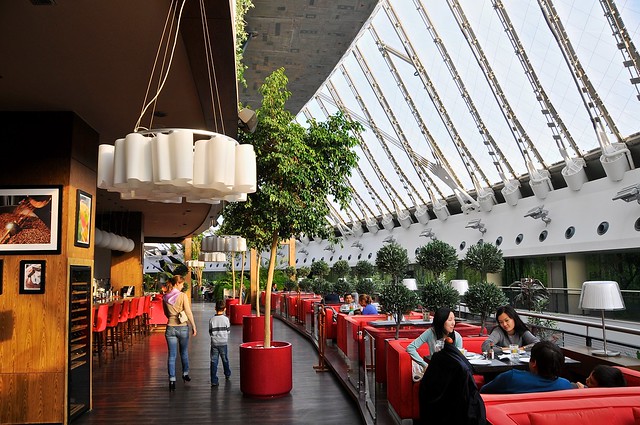 |
| Bars and restaurants ring the penultimate level. |
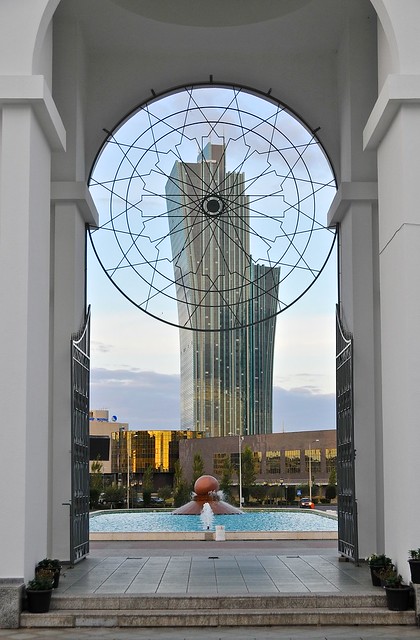 |
| Looking out from the Nur Astana mosque at one of the modern buildings across the way. It's one of the the three Emerald Towers, and it reminds me of a mid-2000's desktop computer. |
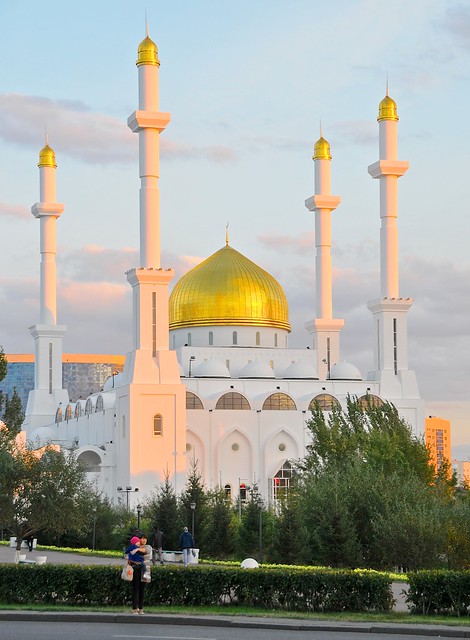 |
| The Nur Astana mosque. Kazakhs are not very religious, and although the government is building mosques and Nazabayev has played up being a Muslim, the government is cautious about encouraging Islam in the face of fundamentalism. In all honesty, every strongman in Central Asia likes a bit of fundamentalism as it gives him a bit of cover to repress targeted populations in the name of anti-terrorism. |
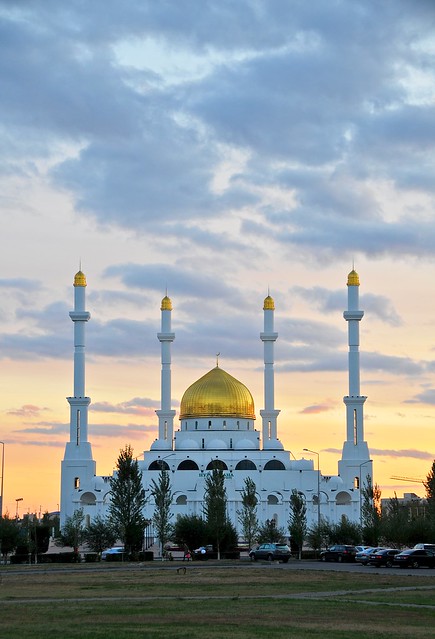 |
| At sunset. |
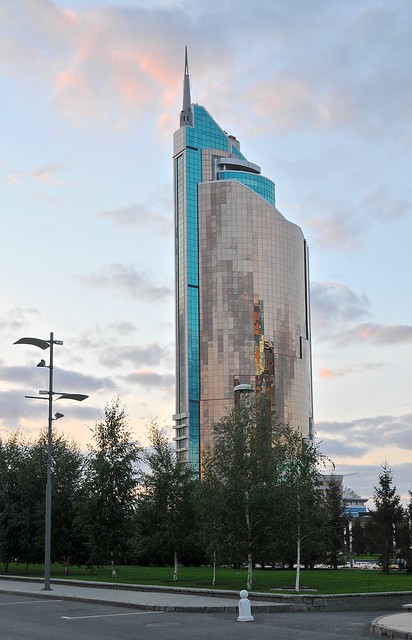 |
| The Ministry of Transportation, more commonly known as "the lighter," somewhat ironically caught fire a few years ago. |
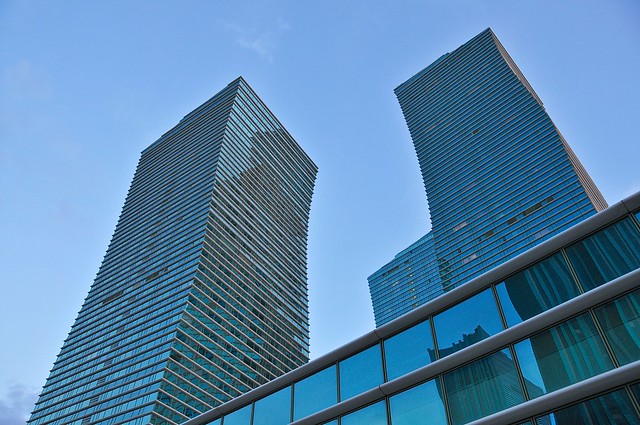 |
| The Northern Lights complex: apartments with wavy sides parked on top of a shopping mall. |
 |
| Looking along the central axis towards Khan Shatyr. The building with the arch in the middle is the state gas company headquarters. |
 |
| Bayterek tower is supposed to resemble a poplar tree holding a Samruk's golden egg, and is often ascribed to Norman Foster. If it is, it would be one of his less successful designs, kind of like his nearby Palace of Peace and Reconciliation. Others say it sprung from the mind of Nazarbayev. Who knows? |
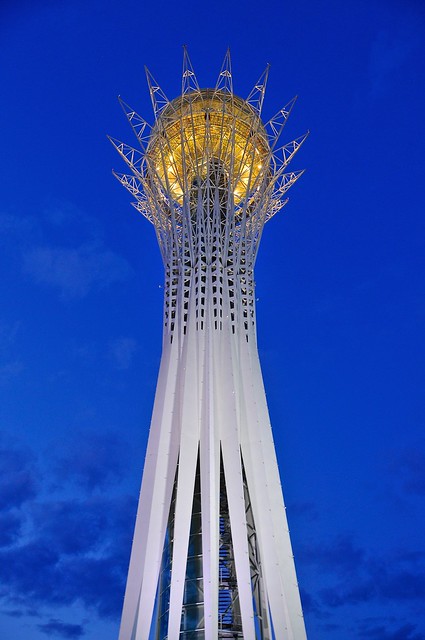 |
| The illumination constantly rotates between colours including yellow, blue, green, purple, and white. Regardless of who designed it, it's often called the Chupa Chups, after the Spanish lollipop brand. |
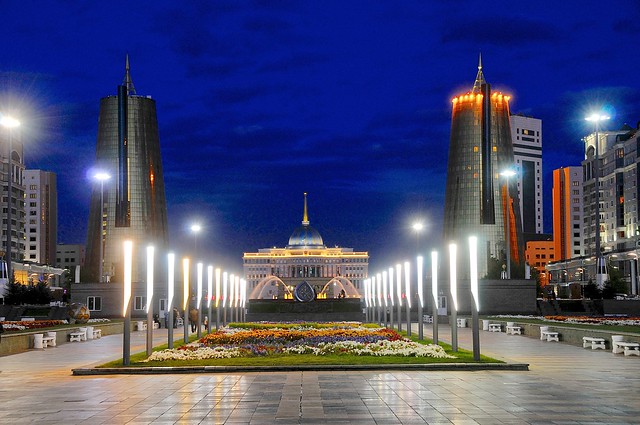 |
| Beyond the Bayterek the avenue continue down towards Ak Orda, the Presidential Palace and Kazakh equivalent of the White House. |
 |
| Yellow contrasts best against the twilight sky. At the top of Bayterek, in the viewing platform, there is a golden mold of Nazarbayev's handprint. On special occasions it will play the national anthem if your hand fits. Like the building itself, Nazarbayev is said to have authored the anthem. |
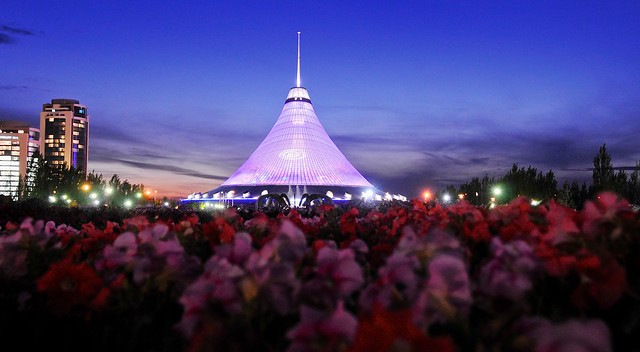 |
| Khan Shatyr over some flowerrs. |
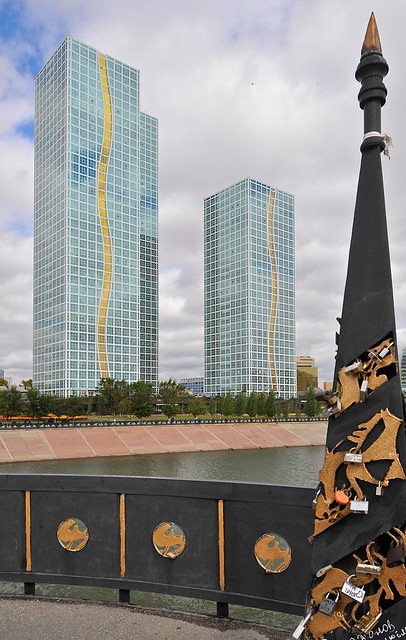 |
| Apartment buildings on the northern side of the river, with a few love locks on the bridge. |
 |
| A Kazakh community education space, which regularly offered classes and entertainment to kids and adults alike. I lost my phone on one of those benches in the plaza. Ironically, I was using it to film my broken Kindle and the page-turning problems it still exhibited, when I probably put it down on the bench and left it there. |
For the most part, you simply don't see many people around the monuments or buildings in Astana: if you actually want to see people, your best bet is to visit the shopping centers like Khan Shatyr or those that occupy the ground floors of the modern apartment buildings that line Nurzhol Boulevard. This civic building, which offered services that actually appeal to residents, was one of the exceptions to the rule of empty streets in the new town.
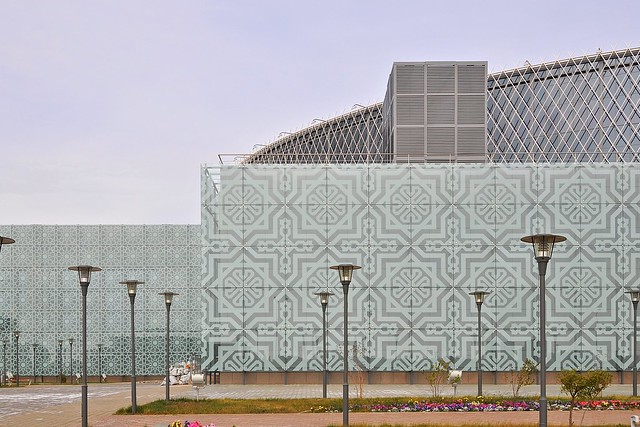 |
| Kazakh designs etched onto the glass. I figured that someone would probably turn my phone in, since it was a 5-year-old original iPhone with smashed glass, but they didn't. I talked to a security guard, who said it hadn't been turned in, but was very interested in showing me videos on his expensive new Samsung Galaxy Note. A passerby who spoke English translated for me and then showed me around the building. It was pretty nice. |
 |
| The Astana Music Hall with its quirky pottery design. |
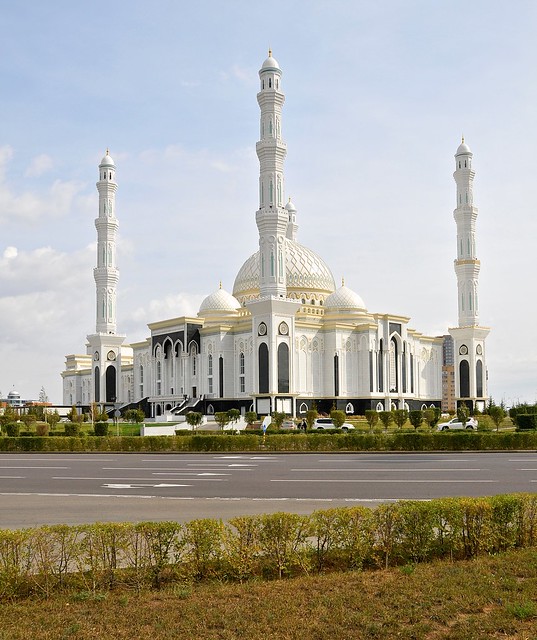 |
| The Hazret Sultan mosque is the largest in Central Asia. I don't know if the road is wide enough to handle all the traffic, though. |
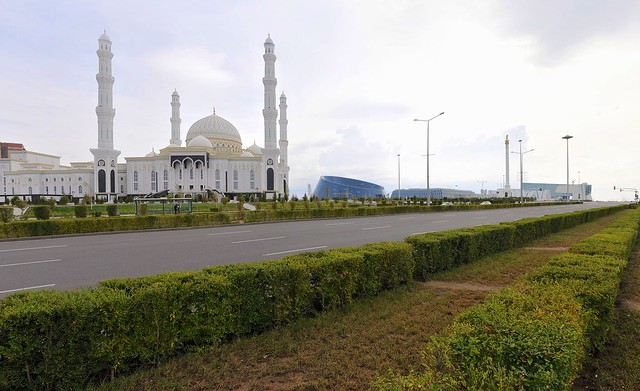 |
| It's located on the far eastern end of the architectural axis, along with the "Dog Bowl" Shabyt Palace, the "Bread Basket" Palace of Independence, the "Chicken on a Stick" Kazakh Eli Monument, and the National Museum. |
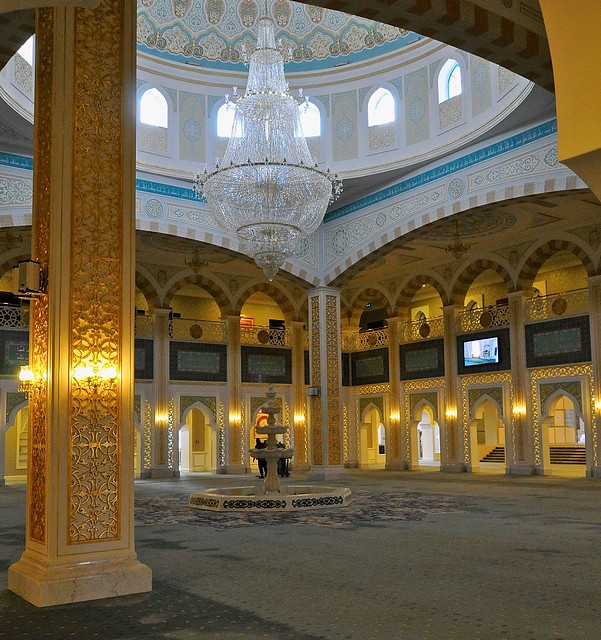 |
| The mosque had opened only a couple of months before I arrived. |
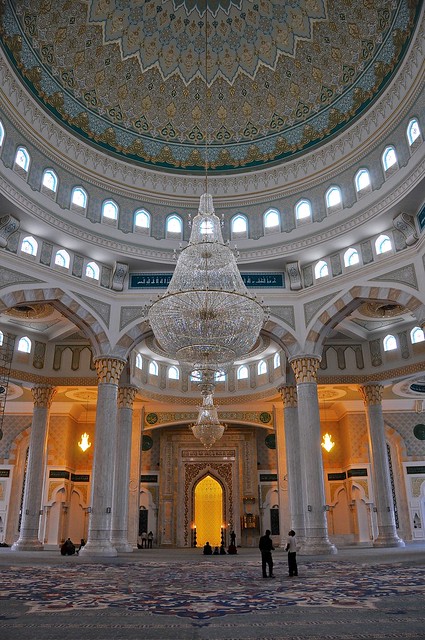 |
| Astana is far enough north that the mihrab faces almost directly southwest, meaning that mosques break up the monotony of the city grid by being aligned diagonally on their blocks. |
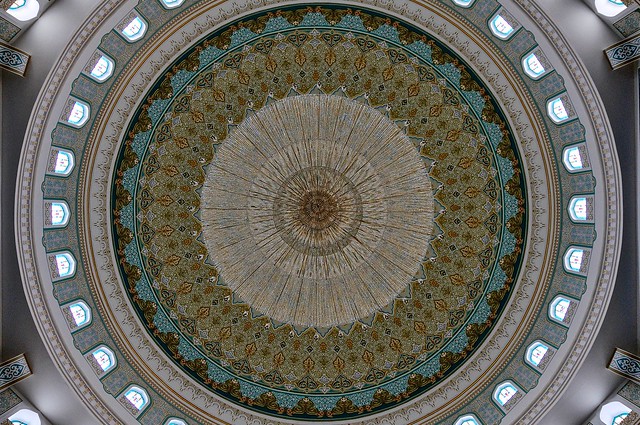 |
| The dome is gorgeous, but apparently the decoration is neither tile nor even paint, but a printed plastic stretched to fit. |
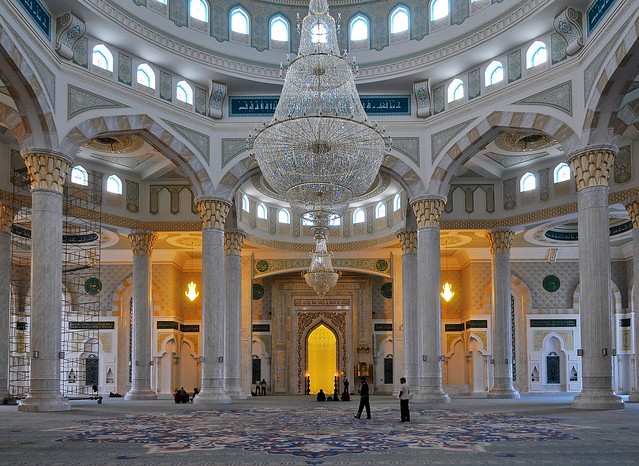 |
| Capacity is said to be 10,000. |
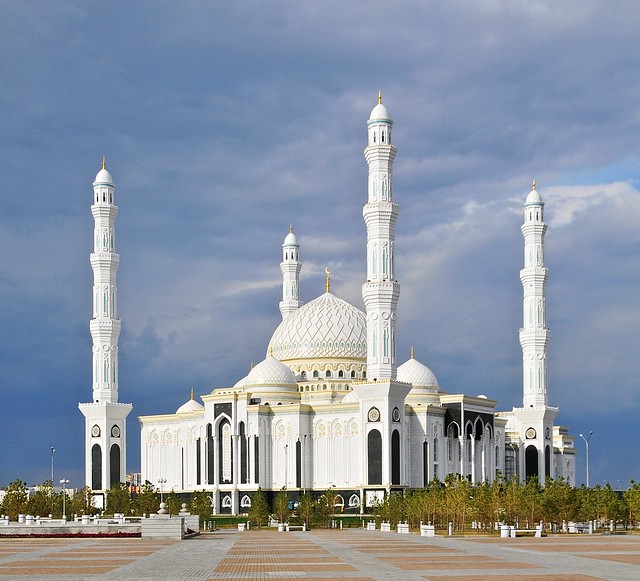 |
| Dramatic clouds behind the mosque. |
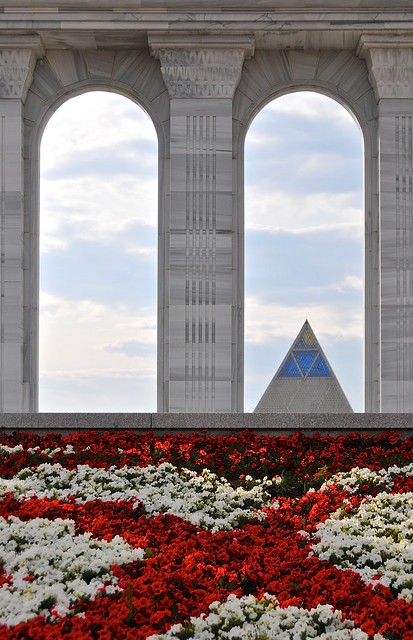 |
| The Palace of Peace and Reconciliation pryamid, through the Kazakh Eli monument. Incidentally, Nazarbayev has proposed changing the country's name to Kazakh Eli in order to get rid of the "-stan" association. |
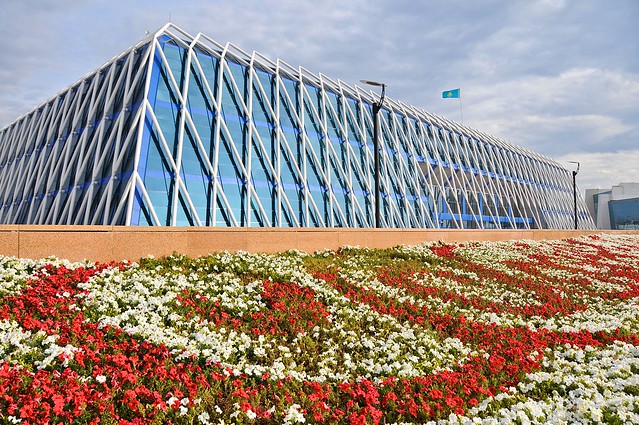 |
| The Kazakh motifs in the flowers are beautiful. |
 |
| I actually like the bread basket's exoskeleton. It adds character in what I imagine is a relatively cost-effective way. |
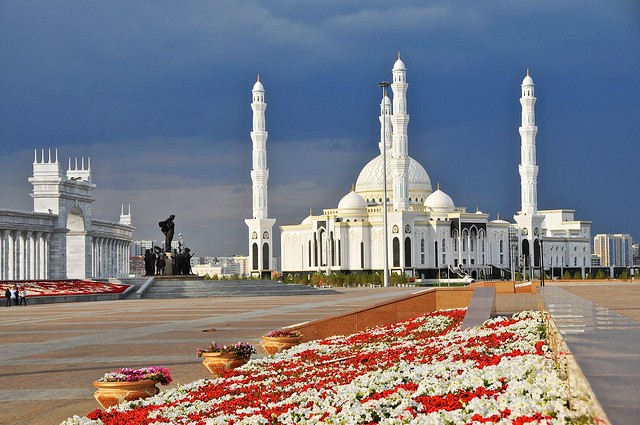 |
| The statue in front of the Kazakh Eli monument is meant to symbolize the unity of the many ethnicities in Kazakhstan. |
 |
| Some of the few tourists you're likely to see. |
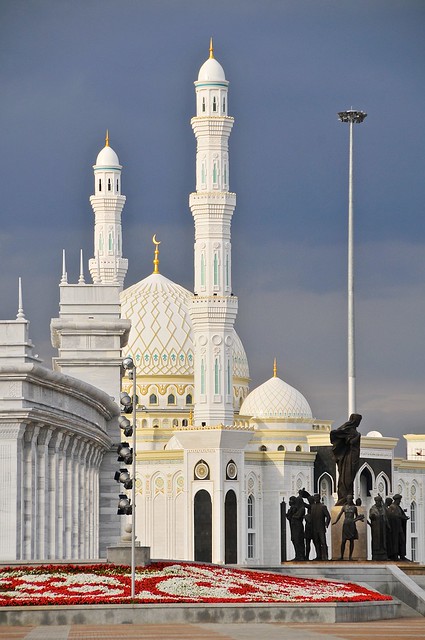 |
| This statue, somewhat surprisingly, is not of Nazarbayev: he's commemorated in a bronze relief at the base of the monumental column, instead. |
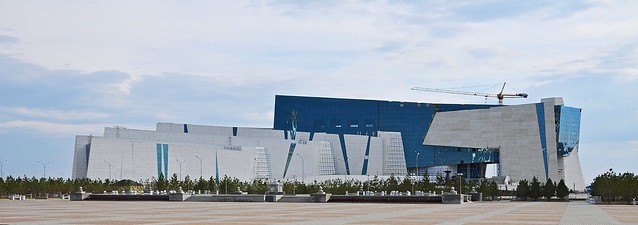 |
| The new National Museum was still two years away from opening when I took this picture. Apparently it's still mostly empty on the inside. |
 |
| The mosque over the ubiquitous flower beds. |
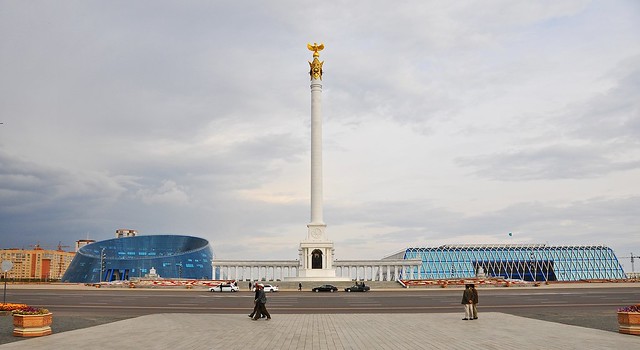 |
| The dog bowl, chicken on a stick, and bread basket, from the entrance to the pyramid. The "chicken" is a samruk, the mythical phoenix-like eagle that is a symbol of Kazakhstan. It continuously lays the egg on the bayterek tree, and the egg is continuously eaten by a snake. |
Developing economies—most notably China—have become an important source of architectural commissions, and lots of architects have commented about how liberating it is to work in those environments, where their projects meet little resistance or oversight and are executed quickly. On the one hand this sounds good, as you get impressive buildings like the CCTV headquarters in Beijing or the Khan Shatyr building here in Astana, but on the other hand it seems like some oversight could lead to better buildings with greater artistic integrity, especially since some of the big-name efforts seem to be the result of lazy commission-chasing. Certainly the two (and possibly three) Norman Foster buildings in Astana seem to be of uneven quality, and security restrictions in some places seem to have compromised how people experience and interact with the buildings (the CCTV headquarters being an example of this). It's difficult to imagine many of the buildings in Astana working as functional buildings, which is a shame.
Although Foster's pyramidal Palace or Peace and Reconciliation is actually kind of interesting on the inside—it was designed as a meeting place for interfaith religious conferences, and contains worship areas for all major religions—the exterior is imposing without being inviting, inspiring, or humane. It appears that the
pyramidal shape may have been dictated by Nazarbayev upon granting the commission, however, which may explain the dreariness of the building even if it calls into question Foster's integrity.
Even on the inside the aesthetic is very cold an impersonal, which seems wrong for a house of spiritual congregation, and the inclusion of an opera house doesn't make a lot of sense, either. Thematically, the message of religious unity and peaceful coexistence is strongly related to the theme of ethnic unity expressed at the opposite Kazakh Eli monument, but the propagandistic nature of both is compromised by just how artificial and inorganic they feel.
Unlike the lollipop, I paid to enter this building, and the tour was actually quite interesting as you got to see almost all of the building, including a small exhibition on the design and construction process.
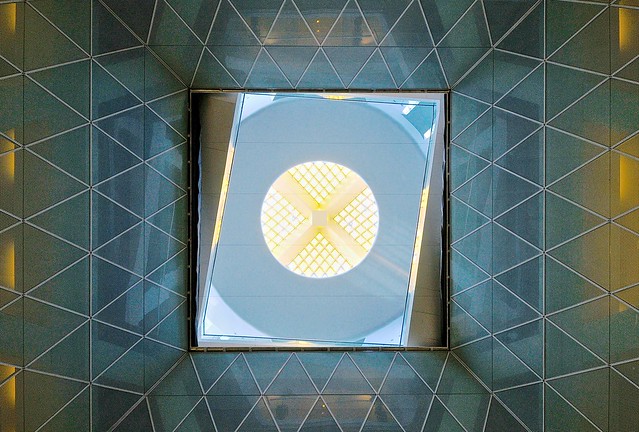 |
| Looking up the central atrium from a lower floor, with views of the top of the pyramid. The angled outline withing the central square are the two sets of stairs leading up to the top floor, which are reminiscent of the two spiral walkways in Berlin's Reichstag Dome, also a Foster design: you are aware of walking over a void towards a glass membrane. |
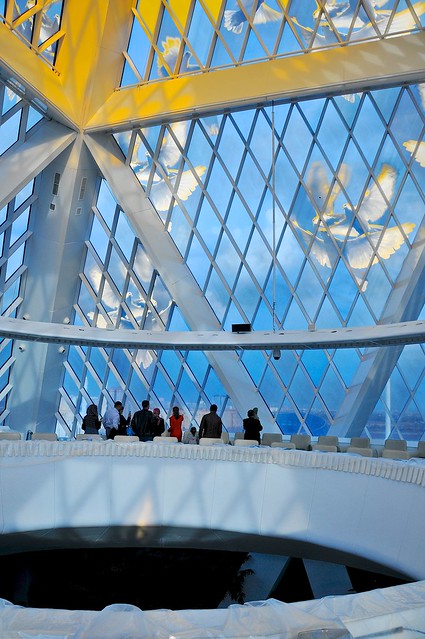 |
| The top floor of the pyramid has a conference room with a huge ring-shaped table modeled on the UN security council chambers,
all below a yellow and blue glass pyramid covered with images of doves
to symbolize peace and unity. The effect is less compelling than hoped. |
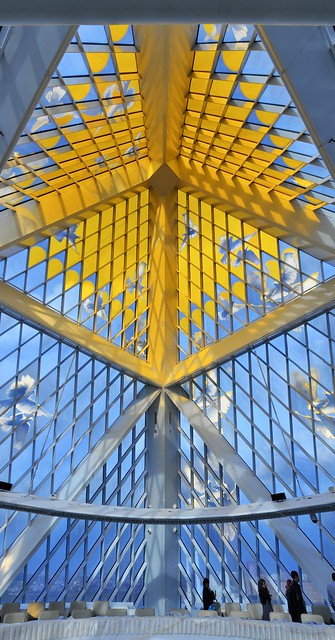 |
| The pyramid in all of its glory is less glorious than one would hope. Is Foster simply chasing empty commissions? |
 |
| The Ishim river is barely a creek outside of Astana. View from the pyramid/old town/right bank side, looking towards the concert hall and Presidential palace. |
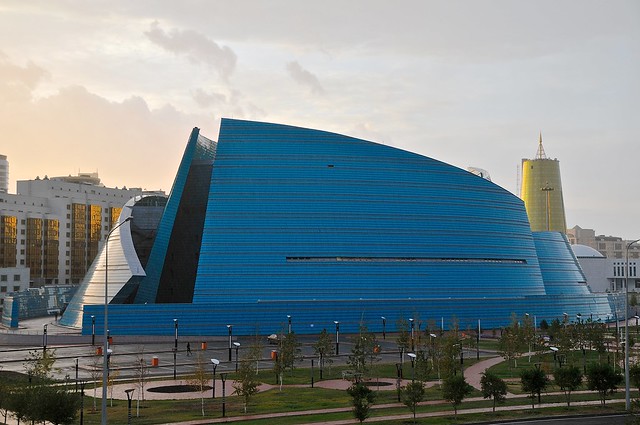 |
| The Concert Hall is an interesting design with gorgeous turquoise glass clearly evoking the colour of the national flag, but at the same time one can't help but feel that the two-dimensional curves are meant to imitate the complex three-dimensional curves the Frank Gehry has used in many of his buildings, including the Walt Disney Concert Hall. |
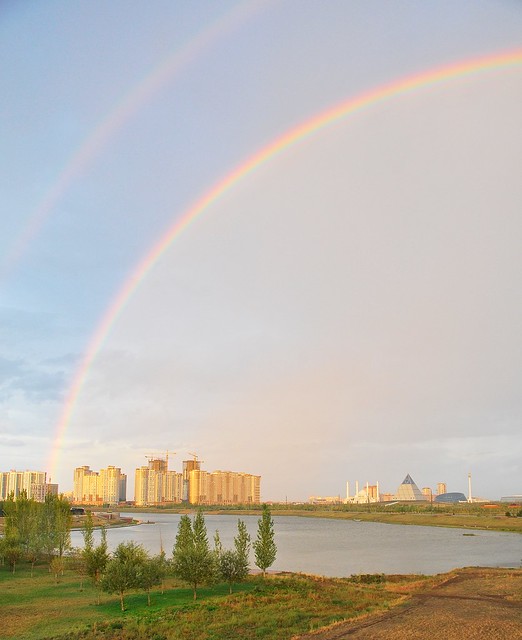 |
| The right bank monuments from the left bank, with a double rainbow all the way. Heck, the main rainbow itself cycled through the spectrum three times. |
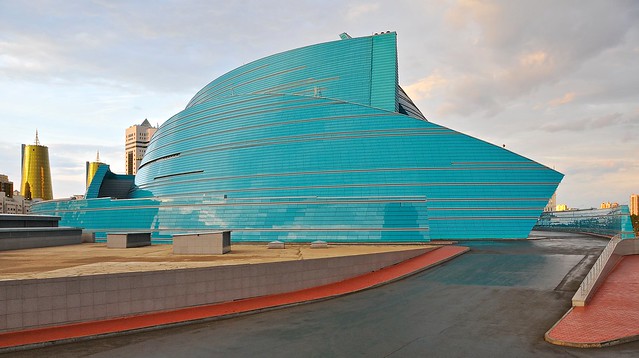 |
| The back of the Concert Hall, but the most prominent view to those who drive past. |
 |
| Detail of the glass panels. |
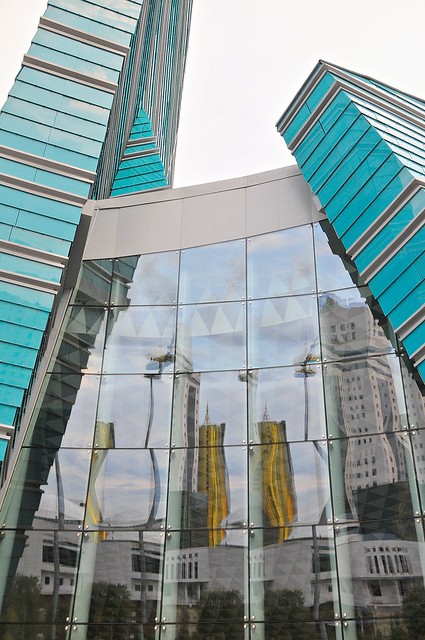 |
| One of the "beer cans" is reflected in the atrium glass. |
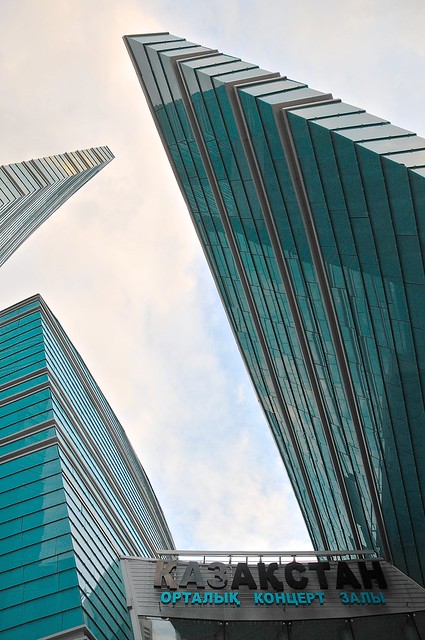 |
| Looking up at the entrance of the Concert Hall. |
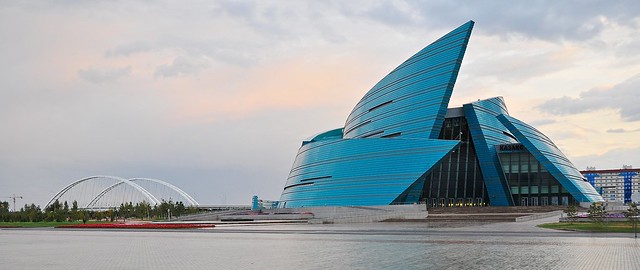 |
| The Concert Hall entrance and Syghanaq bridge in the background. |
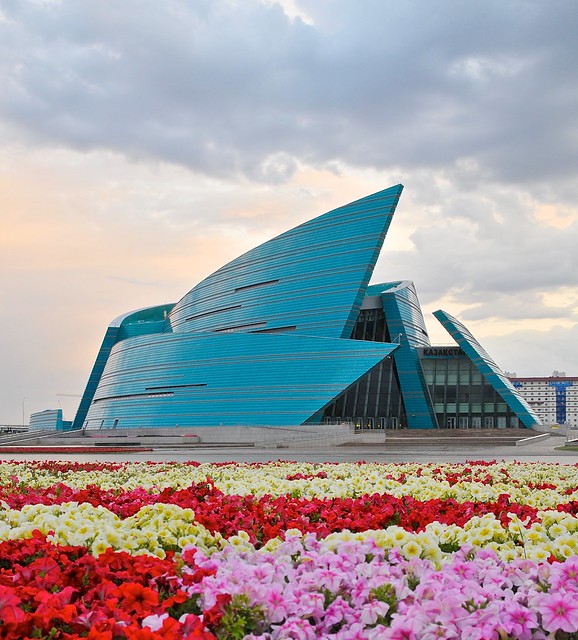 |
| They must spend a fortune on flowers. |
|
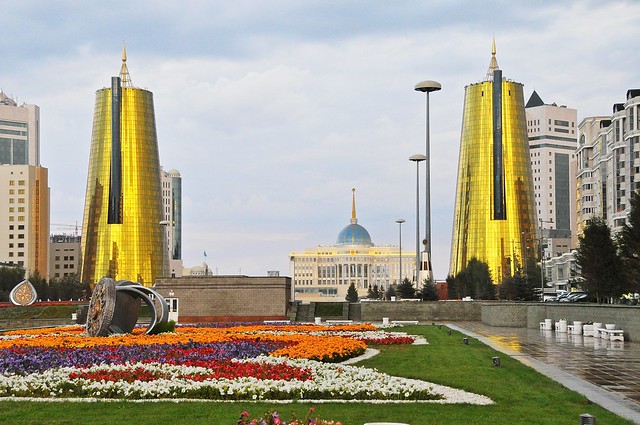 |
| The "beer cans" with the Presidential Palace in the background. |
 |
| A more monumental, imposing, and cynical viewpoint. I wonder what it would look like and how it would feel if it wasn't so empty. |
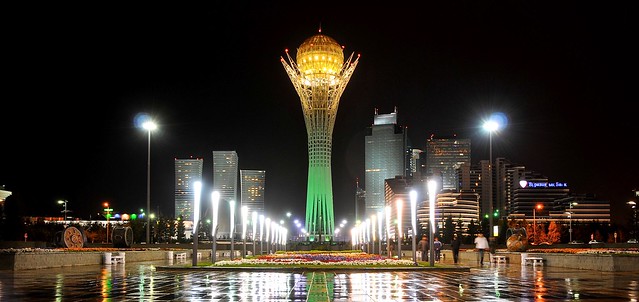 |
| Chupa Chups by night. |
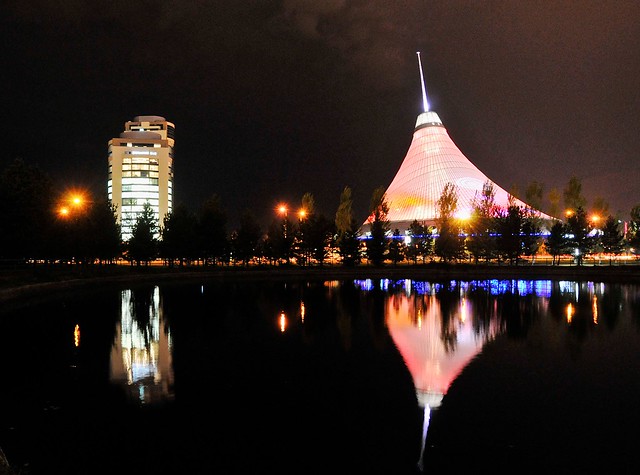 |
| Only one of the apartment buildings that are supposed to ring Khan Shatyr had been built when I was there. |
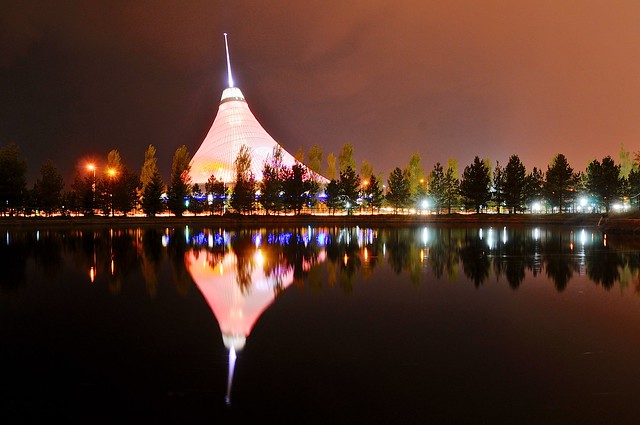 |
| Khan Shatyr reflected in a nearby pool. |
Because Kazakhstan is an expensive place, and especially so in modern, upscale areas like the left bank, I tended to get most of my food at grocery stores (there are always big supermarkets in every mall). The options are surprisingly good for self-caterers, as Kazakhstan supermarkets tend to have a lot of prepared foods pre-packaged in the deli sections, which is something you also see to a lesser extent in Bishkek, but really nowhere else. The options are even broader than you would get in a typical American supermarket, and the prices cheaper than in a restaurant or cafeteria.
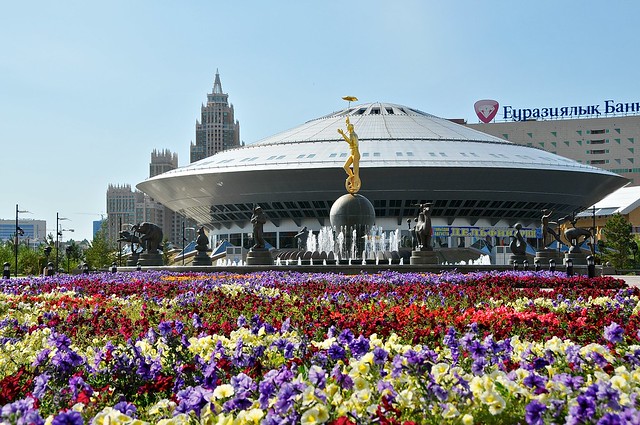 |
| Many Soviet cities have a Circus building. This one was built in 2005. |
Astana has lots of shopping, in modern shopping malls, with western brands. I find it somewhat curious that sporting equipment tends to be most available in places that need it most: prosperous industrialized cities. While it would be difficult to find camping and hiking gear in mountainous, outdoorsy countries like Kyrgyzstan or Tajikistan, it's easy to find this kind of gear in Astana (hundreds, if not thousands, of kilometers from the mountains). I ended up buying a pair of pants on sale here, and they fit decently well even if I made the mistake of assuming I would continue to lose weight, as I typically do while traveling.
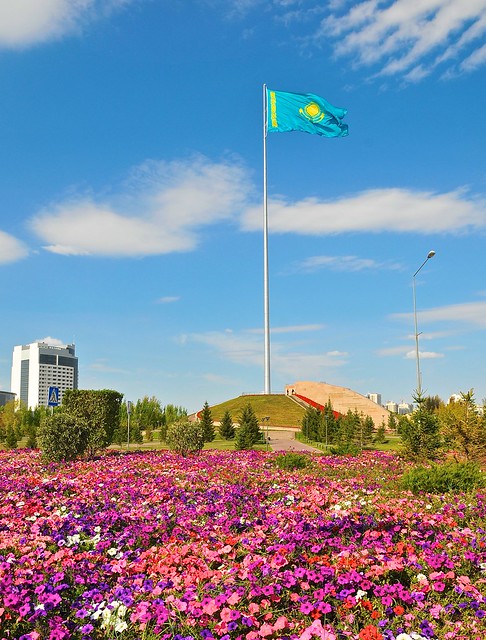 |
| Giant flagpole across from the circus. |
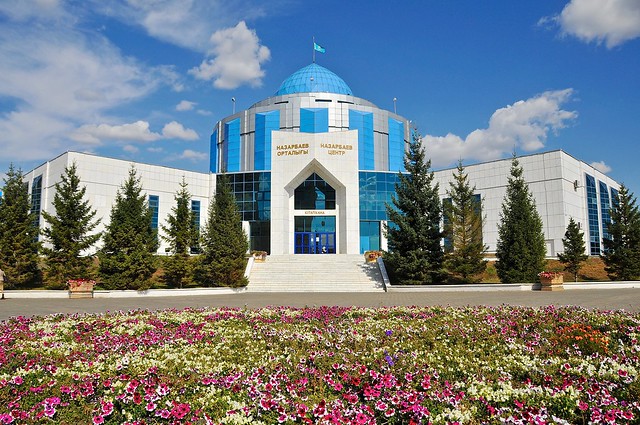 |
| The Nazarbayev Center is surprisingly restrained and modest. |
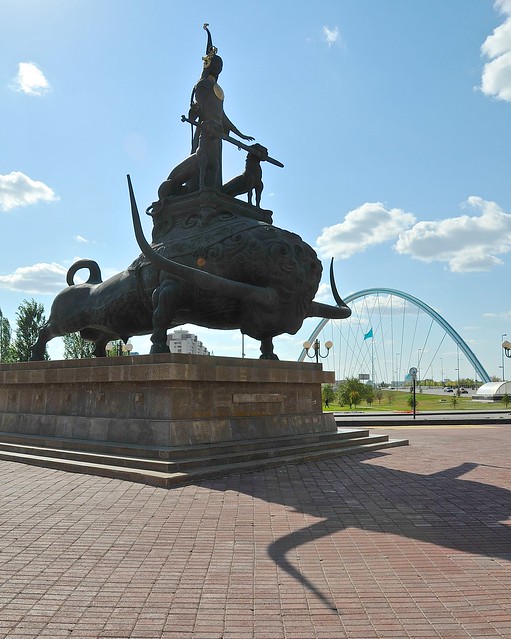 |
| An interesting statue of a bull on the right bank. |
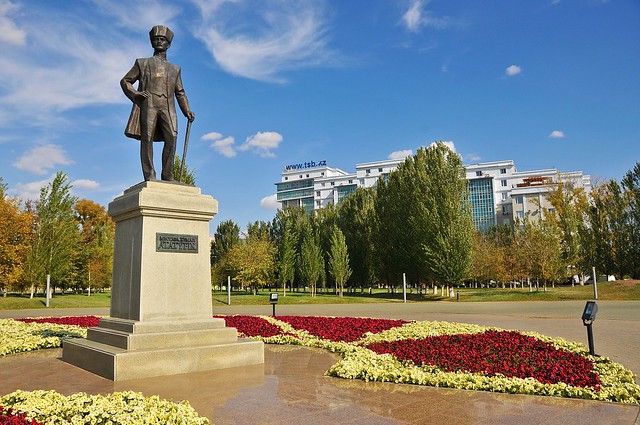 |
| The scenery looks like it could be from a modern Canadian park, though the statue would obviously be out of place, and the architecture is quite frankly newer and more European than you would likely see in Canada (glass curtain with perhaps some steel or brick decoration would be more Canadian). A lot of Astana parks reminded me, for some reason, of the backgrounds of the Garfield cartoons I used to read when I was young: an idealized depiction of an abstract park, with clean simple lawns peppered with pseudo-randomly placed trees and perhaps the odd building in the background. |
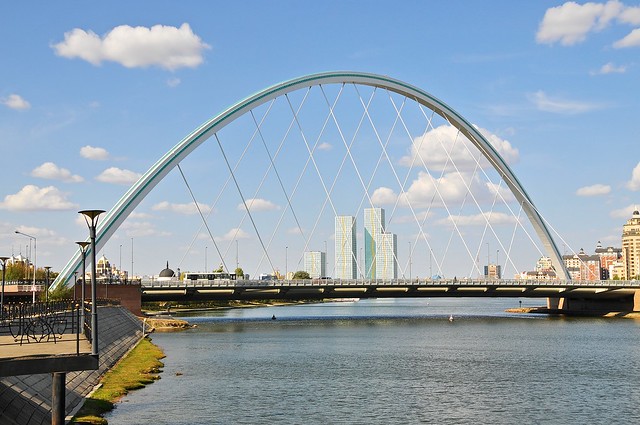 |
| Astana often looks something like an idealized and simplified cartoon, free from the messy complications of historical buildings. |
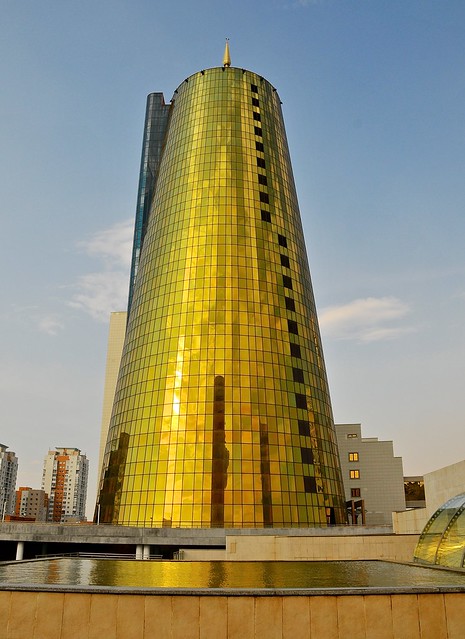 |
| Mirrored glass without any windows, points of entry, or sense of scale frequently ends up looking totalitarian and domineering in a death-star sort of way. |
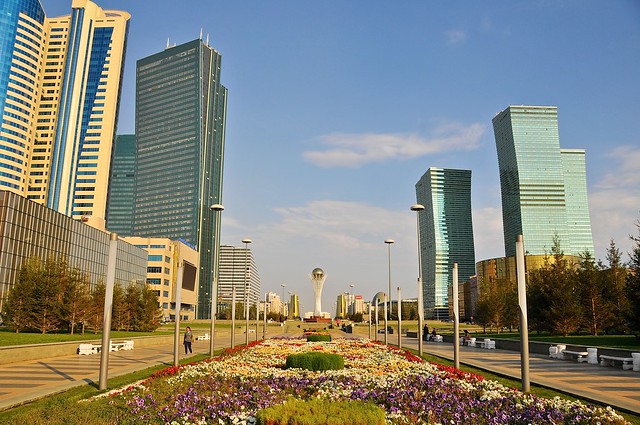 |
| The results are much better shooting with the sun. |
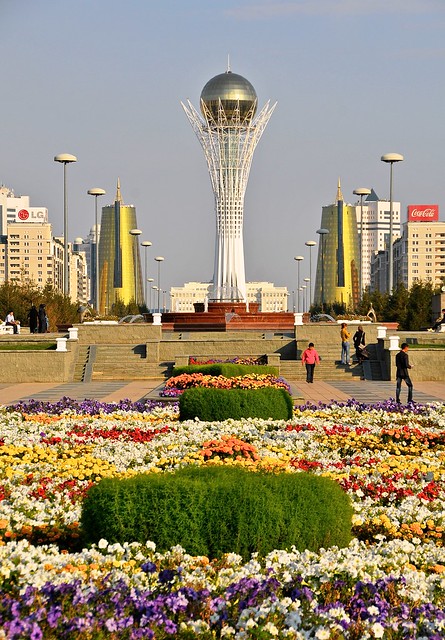 |
| The crowds come out when the weather is nice. |
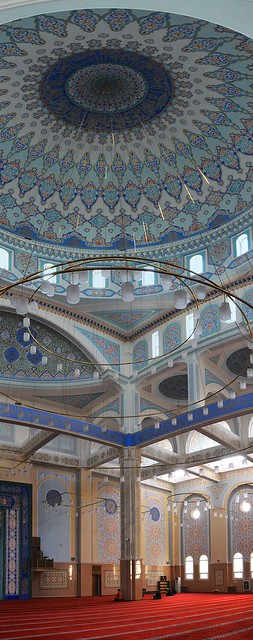 |
| Inside the Nur Astana mosque. |
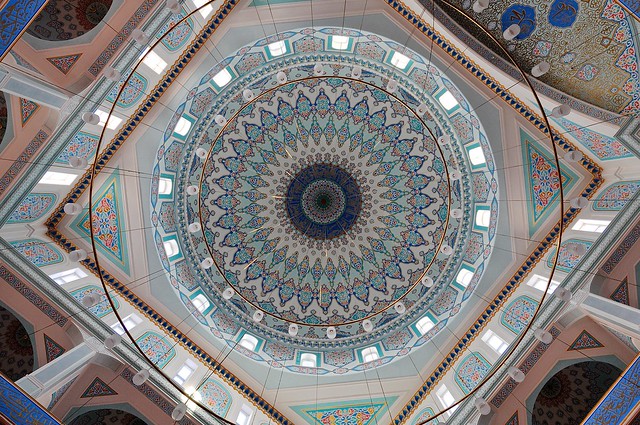 |
| The dome from below. |
 |
| Random horse statue in an empty lot next to the Northern Lights, with the Emerald Towers behind. |
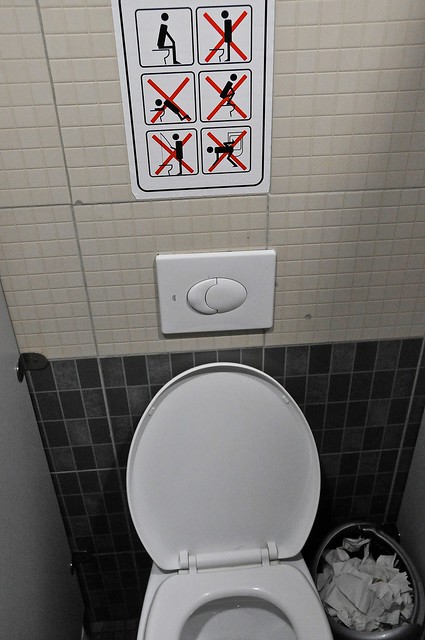 |
| I had seen these signs before, but the was the first time in a clearly non-ironic context. The bin beside the toilet is for used paper, as is customary in most of Asia. |
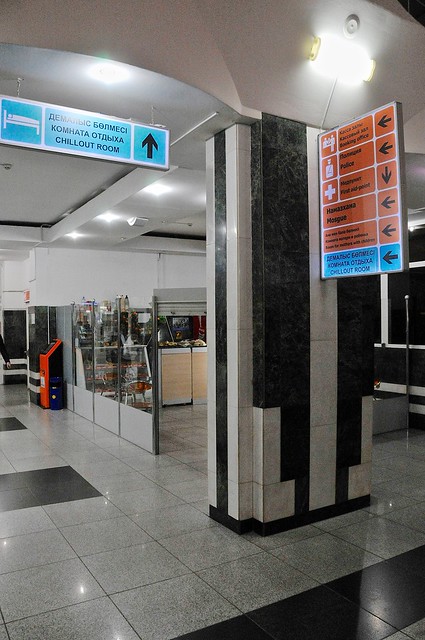 |
| The toilet sign shouldn't have surprised me, given that Astana station has a "chillout room." |
 |
| I'm not sure how I feel about the shooting gallery, though. Thankfully you can get cheap vodka at the store above the sign. |
Astana is an interesting place that manages to capture the ambition of both Nazarbayev and Kazakhstan, while the garish and bizarre architecture and city design also illustrates the conceptual gulf between the Western image they're trying to achieve and the organic and vibrant—if sometimes messy—reality of a modern Western city.
I think that I would probably have a much richer picture of Kazakhstan if I had spent more itme in the country and visited smaller cities and villages, as cities (and capital cities in particular) can give very distorted pictures of what a country is like, especially when the country is run by a strongman intent on burnishing a personality cult (see Dushanbe and Ashgabat for illustrations of this). I mean, the picture I got from the old and new capitals of Almaty and Astana was of a modern, progressive, Russian-oriented nation of considerable prosperity, but aside from the guy on the train playing the
dombra, I had no idea of what Kazakh culture was or what it meant. When I look at the Kazakh motifs expressed in flowerbeds, the tile floors of the Almaty Metro, or etched in the glass of the community center in Astana, what registers in my mind is Kyrgyz culture and the sorts of designs you see in Kyrgyz
shyrdak felt rugs. The golden eagles I saw in Ulaanbaatar are a better example of traditional Kazakh culture than anything I actually saw in Kazakhstan (eagle hunting is practiced by ethnic Kazakhs in the west of Mongolia, likely more so than in Kazakhstan itself). Possibly traditional Kazakh culture asserts itself more in the countryside and in the smaller cities and villages, but if this is true then it's almost certainly true that these places are much, much less prosperous than Almaty and Astana, and that my general impressions of the country are largely incorrect. For as little resemblance as Kazakhstan bears to
Borat, it arguably bears even less resemblance to the Kazakh movie
Tulpan (which is a great movie which I highly recommend).
Interesting links to Astana-related stories and blogs
http://www.newyorker.com/magazine/2011/04/18/nowheresville-2
https://littlemissadventuress.wordpress.com/2010/09/27/post-soviet-urban-planning/
http://www.gerdludwig.com/recent-work/tomorrowland-astana-kazakhstans-new-grandiose-capital-city/#id=album-57&num=content-689
http://beccazsky.blogspot.com/2010/09/astana.html
Budget
September 15, 2012, Astana: 6687 tenge
- Dorm bed at station hotel: 2,500 tenge
- New pants: 2,500 tenge
- Cough medicine: 680 tenge
- Yoghurt and chocolate bars: 400 tenge
- Cheese and chocolate bars: 236 tenge
- Bus: 65 tenge
- Pastry, Coke, wafers, more chocolate: 311 tenge
September 16, Astana: 4965 tenge
- Dorm bed at station hotel: 2,500 tenge
- Shower: 300 tenge
- Bus: 130 tenge
- Pyramid tour: 500 tenge
- Yoghurt, chocolate, coke: 335 tenge
- Plov, potatoes, snickers multipack, bread: 1,000 tenge
- Ice tea & yoghurt: 200 tenge
September 17, Astana to Almaty: 4,010 tenge
- Train to Almaty: 3,240 tenge
- Bus: 130 tenge
- Cake, coffee, yoghurt: 200 tenge
- Potatoes, carrots, ice tea, cheese, fries: 440 tenge
- Lost phone!


























































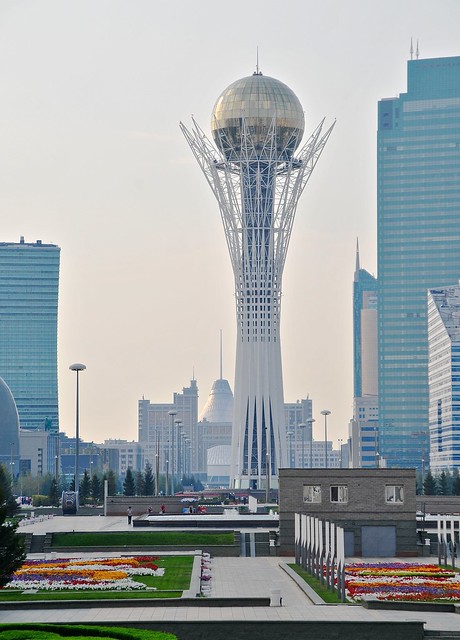















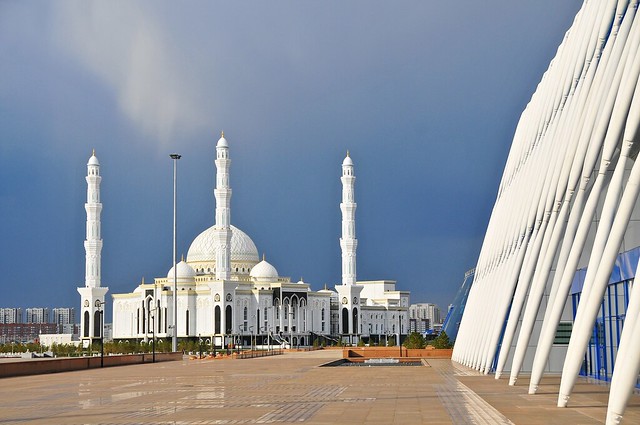


No comments:
Post a Comment